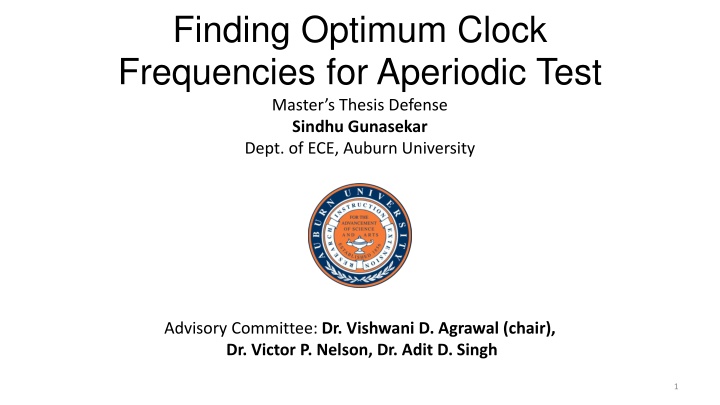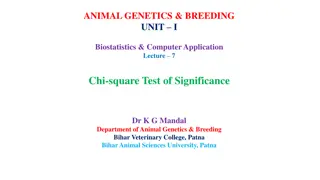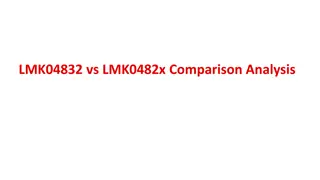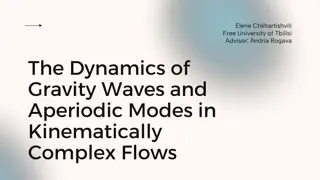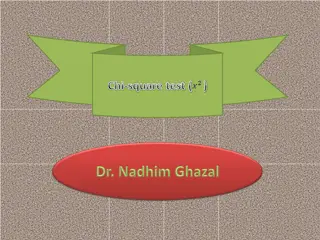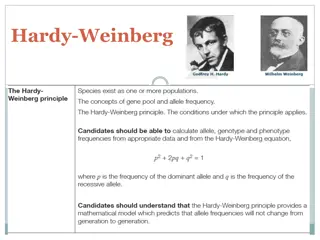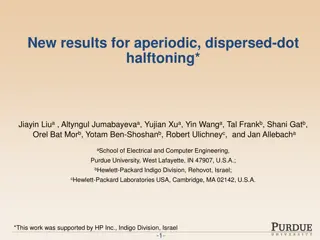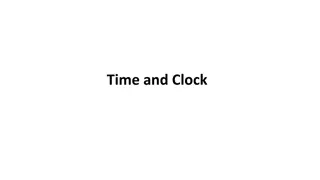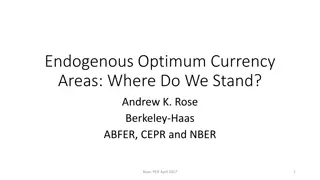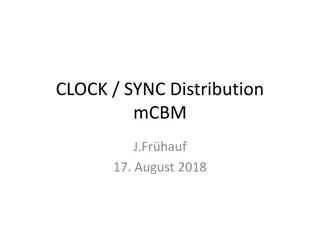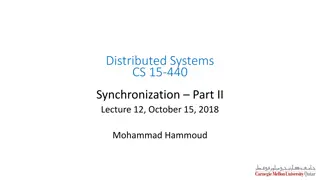Finding Optimum Clock Frequencies for Aperiodic Test
Finding the best clock frequencies for aperiodic testing in integrated circuits is crucial for reducing test time and costs. This study by Sindhu Gunasekar explores the use of aperiodic clock testing to optimize test cycles and minimize power dissipation, ultimately improving testing efficiency.
Download Presentation

Please find below an Image/Link to download the presentation.
The content on the website is provided AS IS for your information and personal use only. It may not be sold, licensed, or shared on other websites without obtaining consent from the author.If you encounter any issues during the download, it is possible that the publisher has removed the file from their server.
You are allowed to download the files provided on this website for personal or commercial use, subject to the condition that they are used lawfully. All files are the property of their respective owners.
The content on the website is provided AS IS for your information and personal use only. It may not be sold, licensed, or shared on other websites without obtaining consent from the author.
E N D
Presentation Transcript
Finding Optimum Clock Frequencies for Aperiodic Test Master s Thesis Defense Sindhu Gunasekar Dept. of ECE, Auburn University Advisory Committee: Dr.Vishwani D. Agrawal (chair), Dr.Victor P. Nelson, Dr. Adit D. Singh 1
Overview Background Problem Statement Algorithm & Implementation Results Conclusion 2
Testing Defects sustained during manufacturing process. Automatic Test Equipment (ATE): Applies input test patterns to CUT Compares CUT output response to known good circuit output response for the given set of input test patterns. 3
Scan Design to increase testability of Sequential circuits Reference: Dr. Nelson s Course Website, Computer Aided Design of Digital Circuits http://www.eng.auburn.edu/~nelson/courses/elec5250_6250/ 4
Advantest T2000GS ATE Used to test integrated circuits for faults after fabrication. Generates test patterns and clock to test the Device Under Test (DUT). Performs measurements and evaluates the test results. Consists of Main System Unit Test Head User Interface 5
Testing cost of ATE Has high initial and recurring costs. The testing cost of using an ATE increases directly with the time spent in testing the chip. Adds to the final cost of the chip. It costs more to test a transistor than to manufacture it. Reducing test time reduces cost of chip. 6
An integrated circuit is designed and packaged to handle the power dissipated during the intended function of the circuit. The ATPG vectors used for testing are generated for high fault coverages and are functionally irrelevant signals. High toggling activity leads to higher power dissipation. If an aperiodic clock is used, in which the clock interval in every cycle can be modified in a way that the dynamic power dissipation remains constant throughout the test within allowable limits, test time can be significantly reduced. 7
Aperiodic clock test to reduce test time Each period can be either structure constrained or power constrained, i.e., ?? ??= max{??????????, } ???????? where, Ti is the period of each test cycle Ei is the energy dissipated by each cycle This is termed as aperiodic clock test where each cycle may not use exactly the same period as its neighboring cycle. For any given voltage an aperiodic clock test can run faster than the periodic clock test at that voltage Reference: Praveen Venkataramani, Reducing ATE Test Time by Voltage and Frequency Scaling. Dissertation Defense, Auburn University, Auburn, Alabama, USA, Nov 2013. 8
Problem Statement The discussed methodology uses an aperiodic clock to reduce the test time. The ATE generates only a limited number of frequencies. Determining an optimum set of frequencies is a discrete optimization problem. This work discusses an algorithm to obtain the optimum set of frequencies for test time reduction. 9
The Optimization Problem Total Test Time = k period ti k is the number of different frequencies the ATE allows ti has to be determined ni ti where ni is number of cycles at the i=1 10
Background Problem Statement Algorithm & Implementation Results Conclusion 11
This is a Combinatorial optimization problem in the discrete domain. It is NP-complete. Using heuristics the NP-complete problem is solved in polynomial-time to find near-optimal solutions. 12
Greedy Algorithm A greedy algorithm makes the locally optimal choice that looks best at each stage. The greedy heuristic does not always yield optimal solutions, but nonetheless it may yield locally optimal solutions that approximate a global optimal solution. One optimum clock period is found by one iteration over all the n different clock intervals, to find which clock interval minimises the test time. The subsequent clocks are found one at each step without altering the clocks found at the previous step. 13
Since greedy algorithm is known to converge to a local optimum, three other algorithms are implemented, but the optimal solutions are observed to be very close the solutions of the greedy algorithm. Iterated local search is when a local search is performed to find a local optimum and then the solution is perturbed to help it escape the local optimum and restart the local search again. 14
Directed Search: One parameter is varied at any time by steps of the same magnitude, and when such increase or decrease did not improve the objective function, the step size is halved and repeated until the steps become sufficiently small. Simulated Annealing: It is a global optimisation method. Annealing is the process of closely controlling the temperature when cooling a material to ensure that it reaches an optimal state. Simulated annealing mimics the process to find an optimum. 15
Background Problem Statement Algorithm & Implementation Results Conclusion 16
Normalised Test Time of s1238 obtained by the greedy algorithm 17
Percentage of Reduction in Test time of the ISCAS 89 benchmarks, with 4, 10 and n frequencies 18
Lower bound of the aperiodic test time obtained with aperiodic clocks using the greedy algorithm by simulating ISCAS '89 benchmark circuits. 19
Normalised test time of the s1238 benchmark obtained through the various algorithms 20
Percentage of reduction in test time of s1238 benchmark circuit obtained by different algorithms 21
CPU time of the four algorithms compared for the s1238 benchmark 22
S298 tested on the ATE T2000GS which allows 4 different frequencies Periodic clock Aperiodic clock with arbitrary frequencies Aperiodic clock with frequencies computed by the greedy algorithm Test time ( s) 270 184 158 Percentage of reduction in test time 0 % 31.85% 41.48 % 23
Periodic clock test ATE result for 540-cycle scan test of s298 benchmark circuit showing test cycles 15 to 45 with a clock of 500ns. 24
Aperiodic clock test ATE result for 540-cycle scan test of s298 benchmark circuit showing test cycles 15 to 66 with a clock periods of 219ns, 274ns, 342ns and 500ns. 25
Conclusion The greedy algorithm to find optimum clock frequencies is proven to be as good as any of the other local search and global search algorithms, and faster than all of them. As few as four frequencies can give a test time reduction up to 52% in a few circuits, and the computation could be completed in a time of the order of milliseconds. Ten clock frequencies are optimum for test time reduction for most of the benchmark circuits simulated in this work, beyond which the test time reduction is negligible. 26
Future Work The high costs of automatic test equipment (ATE) and the growing clock frequencies bring about the need to study on-chip clock generation circuitry for generation of aperiodic clocks, which can be implemented in BIST circuits where the test patterns are generated on-chip. 27
References P. Venkataramani and V. D. Agrawal, ATE Test Time Reduction Using Asynchronous Clocking, in Proc. International Test Conf., Sept. 2013. Paper 15.3. T. H. Cormen, C. E. Leiserson, R. L. Rivest, C. Stein, et al., Introduction to algorithms, volume 2. MIT press Cambridge, 2001. P. Mangilipally and V. P. Nelson, Emulation of Slave Serial Mode to Configure the Xilinx Spartan 3 XC3S50 FPGA Using Advantest T2000 Tester, in Technical report, Auburn University, 2011. S. Luke, Essentials of Metaheuristics. Lulu, second edition, 2013. Available at http://cs.gmu.edu/sean/book/metaheuristics/ P. Venkataramani, Reducing ATE Test Time by Voltage and Frequency Scaling. PhD thesis, Auburn University, Auburn, Alabama, USA, May 2014. P. Venkataramani, S. Sindia, and V. D. Agrawal, A Test Time Theorem and Its Applications, in Proc. 14th IEEE Latin-American Test Workshop, Apr. 2013. 28
